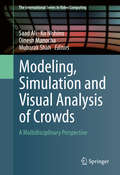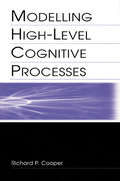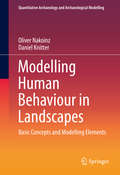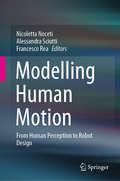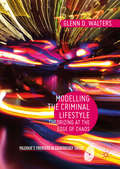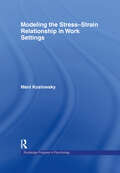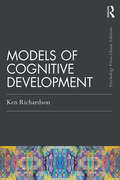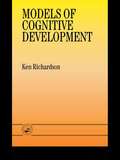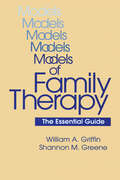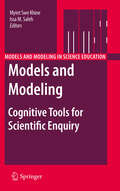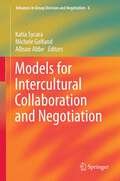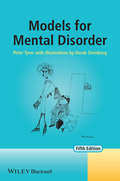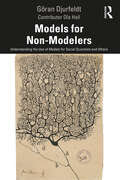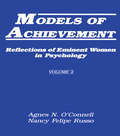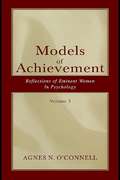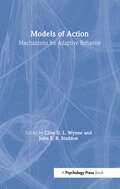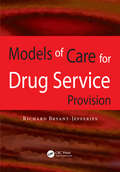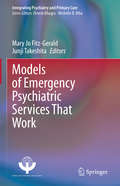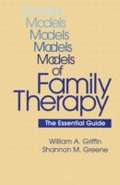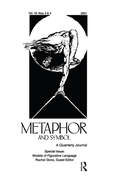- Table View
- List View
Modeling, Simulation and Visual Analysis of Crowds
by Mubarak Shah Saad Ali Ko Nishino Dinesh ManochaOver the last several years there has been a growing interest in developing computational methodologies for modeling and analyzing movements and behaviors of 'crowds' of people. This interest spans several scientific areas that includes Computer Vision, Computer Graphics, and Pedestrian Evacuation Dynamics. Despite the fact that these different scientific fields are trying to model the same physical entity (i. e. a crowd of people), research ideas have evolved independently. As a result each discipline has developed techniques and perspectives that are characteristically their own. The goal of this book is to provide the readers a comprehensive map towards the common goal of better analyzing and synthesizing the pedestrian movement in dense, heterogeneous crowds. The book is organized into different parts that consolidate various aspects of research towards this common goal, namely the modeling, simulation, and visual analysis of crowds. Through this book, readers will see the common ideas and vision as well as the different challenges and techniques, that will stimulate novel approaches to fully grasping "crowds. "
Modelling Command and Control: Event Analysis of Systemic Teamwork (Human Factors in Defence)
by Neville A. Stanton Chris BaberSince its inception, just after the Second World War, Human Factors research has paid special attention to the issues surrounding human control of systems. Command and control environments continue to represent a challenging domain for human factors research. Modelling Command and Control takes a broad view of command and control research, to include C2 (command and control), C3 (command, control and communication), and C4 (command, control, communication and computers) as well as human supervisory control paradigms. The book presents case studies in diverse military applications (for example, land, sea and air) of command and control. The book explores the differences and similarities in the land, sea and air domains; the theoretical and methodological developments, approaches to system and interface design, and the workload and situation awareness issues involved. It places the role of humans as central and distinct from other aspects of the system. Using extensive case study material, Modelling Command and Control demonstrates how the social and technical domains interact, and why each require equal treatment and importance in the future.
Modelling High-level Cognitive Processes
by John Fox Richard P. Cooper With Contributi Peter G. Yule David W. Glasspool Richard P. CooperThis book is a practical guide to building computational models of high-level cognitive processes and systems. High-level processes are those central cognitive processes involved in thinking, reasoning, planning, and so on. These processes appear to share representational and processing requirements, and it is for this reason that they are considered together in this text. The book is divided into three parts. Part I considers foundational and background issues. Part II provides a series of case studies spanning a range of cognitive domains. Part III reflects upon issues raised by the case studies. Teachers of cognitive modeling may use material from Part I to structure lectures and practical sessions, with chapters in Part II forming the basis of in-depth student projects. All models discussed in this book are developed within the COGENT environments. COGENT provides a graphical interface in which models may be sketched as "box and arrow" diagrams and is both a useful teaching tool and a productive research tool. As such, this book is designed to be of use to both students of cognitive modeling and active researchers. For students, the book provides essential background material plus an extensive set of example models, exercises and project material. Researchers of both symbolic and connectionist persuasions will find the book of interest for its approach to cognitive modeling, which emphasizes methodological issues. They will also find that the COGENT environment itself has much to offer.
Modelling Human Behaviour in Landscapes
by Oliver Nakoinz Daniel KnitterThis volume is designed as a 12-lecture textbook, which can serve as a course companion, self teaching guide and handbook for basic concepts. Each lecture comprises 20 pages, in which the methods are introduced, examples shown and the code is given. All examples are computed with open source software, mainly R, and with archaeological data available from the book's website. The book does not describe elaborated high-end models but rather very basic modelling concepts that serve as components in more complex models. The book enables the reader to construct such models by themselves and be sensitive for certain problems. In addition it gives hints for the interpretation of the results. Students are usually quick to apply fancy methods yet fail in the proper interpretation due to a lack of understanding of the underlying principles. This problem is addressed by the proposed book through three concepts: 1. Command line software forces the students to first learn some details before they are able to produce results on their own. 2. The book is focused on principles and methods. When the students understand a few basic principles, they have far better access to a wide range of related methods. 3. Examples of poor analysis highlight common pitfalls. The volume attempts to be an applied, minimalistic and efficient textbook and is based upon several successful courses.
Modelling Human Motion: From Human Perception to Robot Design
by Nicoletta Noceti Alessandra Sciutti Francesco ReaThe new frontiers of robotics research foresee future scenarios where artificial agents will leave the laboratory to progressively take part in the activities of our daily life. This will require robots to have very sophisticated perceptual and action skills in many intelligence-demanding applications, with particular reference to the ability to seamlessly interact with humans. It will be crucial for the next generation of robots to understand their human partners and at the same time to be intuitively understood by them. In this context, a deep understanding of human motion is essential for robotics applications, where the ability to detect, represent and recognize human dynamics and the capability for generating appropriate movements in response sets the scene for higher-level tasks. This book provides a comprehensive overview of this challenging research field, closing the loop between perception and action, and between human-studies and robotics. The book is organized in three main parts. The first part focuses on human motion perception, with contributions analyzing the neural substrates of human action understanding, how perception is influenced by motor control, and how it develops over time and is exploited in social contexts. The second part considers motion perception from the computational perspective, providing perspectives on cutting-edge solutions available from the Computer Vision and Machine Learning research fields, addressing higher-level perceptual tasks. Finally, the third part takes into account the implications for robotics, with chapters on how motor control is achieved in the latest generation of artificial agents and how such technologies have been exploited to favor human-robot interaction. This book considers the complete human-robot cycle, from an examination of how humans perceive motion and act in the world, to models for motion perception and control in artificial agents. In this respect, the book will provide insights into the perception and action loop in humans and machines, joining together aspects that are often addressed in independent investigations. As a consequence, this book positions itself in a field at the intersection of such different disciplines as Robotics, Neuroscience, Cognitive Science, Psychology, Computer Vision, and Machine Learning. By bridging these different research domains, the book offers a common reference point for researchers interested in human motion for different applications and from different standpoints, spanning Neuroscience, Human Motor Control, Robotics, Human-Robot Interaction, Computer Vision and Machine Learning.Chapter 'The Importance of the Affective Component of Movement in Action Understanding' of this book is available open access under a CC BY 4.0 license at link.springer.com.
Modelling the Criminal Lifestyle
by Glenn D. WaltersThis book offers Walters's latest evolution of criminal lifestyle theory. It introduces the concept of criminal thought content to illustrate how the potential interplay between what offenders think and their thought processes can greatly aid our understanding of both crime and criminals. In this new study on criminal behaviour, Walters calls for criminological theory to be placed within a broader scientific context, and provides us with several key models which embrace constructs from numerous important theories including: the general theory of crime, social cognitive and social learning theories, general strain theory, psychopathic personality theories of crime, and labelling theory. Another unique aspect of this work is that it places lifestyle theory within a larger scientific framework, namely, nonlinear dynamical systems theory or chaos. Seven principles from chaos theory are used to explain relationships and processes central to lifestyle theory and Walters uses this to draw conclusions on what affects criminal decision-making and desistance from crime. Highly original and innovative in scope, this book will be useful to practitioners and scholars of criminal justice alike, with chapters focussed on decision-making, assessment, and intervention.
Modelling the Stress-Strain Relationship in Work Settings (Routledge Progress in Psychology)
by Meni KoslowskyMeni Koslowsky presents here for the first time a way of modelling stress-strain that will enable researchers to both assess examples from the literature and correctly define and use the model in their own investigations. All stages from construction of the model to data analysis are covered, along with possible pitfalls.This book enables investigators to develop and test models for describing stress phenomena in their own settings. It provides an essential research tool for all those who assess stress and strain in their working lives.
Modelo humanizar de intervencion en duelo
by Marisa Magaña Loarte José Carlos BermejoDesde 1997 el Centro de Humanización de la Salud cuenta con un servicio de atención a personas en duelo llamado Centro de Escucha San Camilo.<P><P> Miles de personas con dificultades para afrontar su pérdida han entregado su experiencia más íntima y dolorosa a los oídos y al corazón de otro ser humano, confiando en el poder terapéutico de la acogida empática, la escucha comprensiva y el respeto al modo de sentir y expresar el dolor por la ausencia del ser amado.<P> El duelo es una verdadera crisis existencial y se describe como el conjunto de reacciones emotivas y conductuales a la pérdida de un ser querido. Dicha crisis puede servirnos para crecer o para debilitarnos y enfermar, dependiendo de cómo la afrontemos.<P> Hay personas que necesitan ayuda para elaborar el duelo y la encuentran en el Centro de Escucha San Camilo de Madrid que, a lo largo de estos años, ha elaborado su propio modelo de intervención recogido en este libro. Hoy existen en España más de 15 Centros que se inspiran en él.<P> MARISA MAGAÑA es psicóloga, máster en counselling y en duelo, directora del Centro de Escucha San Camilo y coordinadora del máster en duelo (Universidad Ramón Llull) en el Centro de Humanización de la Salud.<P> JOSÉ CARLOS BERMEJO, doctor en teología pastoral sanitaria y máster en counselling, en duelo y en bioética, es director del Centro de Humanización de la Salud (religiosos camilos), director del máster en duelo (Universidad Ramón Lull) y profesor también en el Camillianum de Roma y en la Universidad Católica de Portugal.
Models Of Cognitive Development (Psychology Press & Routledge Classic Editions)
by Ken RichardsonIn spite of its obvious importance and popularity, the field of cognitive development remains highly fragmented due to the vast diversity of models of what knowledge and reasoning are, and how they develop. This new Classic Edition of Models of Cognitive Development aims to overcome this barrier through its careful introduction, illustrated examples, and approach to helping students think more critically about the subject. In this significant work, Richardson provides students, researchers, and comparative theoreticians with a cohesive understanding of the area by organizing diverse schools, frameworks, and approaches according to a much smaller set of underlying assumptions or preconceptions, which themselves can be historically interrelated. By understanding these, it’s possible to find pathways around the area more confidently as a whole, to see the “wood” as well as the theoretical trees, and be able to react to individual models more critically and constructively. The Classic Edition of this core text will be essential reading for undergraduate and graduate students of cognitive development.
Models Of Cognitive Development (Psychology Press And Routledge Classic Editions Ser.)
by Ken Richardson Dr Ken RichardsonIn spite of its obvious importance and popularity, the field of cognitive development remains highly fragmented, scientifically. Instead of theoretical convergence towards a generally accepted set of principles, there remains a vast diversity of models of what knowledge and reasoning are, and how they develop. Courses and books tend to deal with this perplexing situation by simply presenting students with either a specific, favoured line, or by offering selections from the theoretical salad. As a result, students have great difficulty in obtaining a cohesive picture of the area. They are frequently bewildered by the diversity of schools, frameworks and approaches, with seemingly little connection between them. More seriously, they are deprived of a critical grasp of the area, and thus forced into a habit of early selectivity, rote memory of specific models in isolation, and regurgitation at exams. This in turn deprives the area of cognitive development of important critical impetus for future improvement. Models of Cognitive Development is an attempt to overcome these problems. It does this by arguing that the vast diversity of theories or models can be organised into groups according to a much smaller set of underlying assumptions or preconceptions, which themselves can be historically interrelated. By understanding these, students may be helped to find their way more confidently around the area as a whole, to see the 'wood' as well as the theoretical forest, and thus find themselves in a position to react to individual models more positively and more critically. Such criticism may, in turn, assist theoretical progress and unity in the future. Models of Cognitive Development covers all the contemporary theoretical and research strands in the area, with numerous examples, in a clear and straightforward manner, and should be useful to all students, researchers, and comparative theoreticians in the area.
Models Of Family Therapy: The Essential Guide
by Shannon M. Greene William A. GriffinModels of Family Therapy provides an overview of established family therapy models. All classification schemes of family therapy models must reduce ideological complexity, ignore overlap, and generalize for the purposes of category inclusion and exclusion. Nonetheless, orientation differences do exist and the authors make these differences clear by placing ideas and methods into categories. To facilitate learning how the dimensions of each model fit with other models, this book enhances comparability by using the same general outline in all chapters. In these outlines, the critical components of each model are broken down into a few core assumptions, terms, techniques, and methods. These critical components are summarized consistent with their description in the original publications. Some of these models include structural, strategic, behavioral, psychoeducational, and experiential therapy.Because of the style of presentation, this book can be useful as a primary text or supplement in a marriage and family therapy course. In addition, graduate students and professionals can benefit from this guidebook in order to prepare for any state or national examination on marriage and family therapy.
Models Of Short-Term Memory
by Susan E. GathercoleThis volume offers a collection of theoretical perspectives in the area of short-term memory. It contains overviews of models of short-term memory, with particular emphasis placed on the detailed description of the functioning of the models. The volume represents both computational approaches and theories expressed in more traditional verbal form. Models represented in the volume also cover both developmental and neuropsychological perspectives on short-term memory.; This book should appeal to active researchers in the area of memory, to graduate students, and to academics who wish to update their knowledge of this fast- developing are of research and theory. Final year undergraduates may also find this book of interest.
Models and Modeling
by Myint Swe Khine Issa M. SalehThe process of developing models, known as modeling, allows scientists to visualize difficult concepts, explain complex phenomena and clarify intricate theories. In recent years, science educators have greatly increased their use of modeling in teaching, especially real-time dynamic modeling, which is central to a scientific investigation. Modeling in science teaching is being used in an array of fields, everything from primary sciences to tertiary chemistry to college physics, and it is sure to play an increasing role in the future of education. Models and Modeling: Cognitive Tools for Scientific Enquiry is a comprehensive introduction to the use of models and modeling in science education. It identifies and describes many different modeling tools and presents recent applications of modeling as a cognitive tool for scientific enquiry.
Models as Make-Believe
by Adam ToonScientists often try to understand the world by building simplified and idealised models of it. Adam Toon develops a new approach to scientific models by comparing them to the dolls and toy trucks of children's imaginative games, and offers a unified framework to solve difficult metaphysical problems and help to make sense of scientific practice.
Models for Intercultural Collaboration and Negotiation
by Michele Gelfand Katia Sycara Allison AbbeThis book is the first to bring together research material from different communities, Computer Science and especially Artificial Intelligence, and Social Sciences, e.g. Anthropology, Social Psychology, Political Science that present ideas and viewpoints, methods and models on inter-cultural collaboration and negotiation. With increasing globalization of business and science, cultural differences of the parties are an important factor that affects the process and outcomes of collaborative and self-interested interactions. The social science literature on culture as well as human collaboration and negotiation is vast. Most of this literature is devoted to work within the same culture. Artificial intelligence researchers, on the other hand, have developed computational models of cooperation, conflict resolution and negotiation, but paying almost no attention to identifying and modeling cultural factors. In recent years, we have witnessed a great increase in interest in understanding inter-cultural interactions. This has led to increased interest of social scientists and computational scientists in theoretical and experimental analysis of inter-cultural exchanges, modeling and support. Currently, these communities are largely unconnected. There is a great need to bring them together to share research work and experiences, discuss ideas and forge interdisciplinary collaborative relations. This book will be of interest to researchers from AI/computer science and social/behavioral sciences fields, such as psychology, sociology, communications, organizational science.
Models for Mental Disorder
by Peter TyrerModels for Mental Disorder, first published in 1987, anticipated the move towards integration of psychiatric services into multidisciplinary teams (doctor, psychologist, nurse, social worker, etc) and the need to bring together the different philosophies of mental illness. Peter Tyrer has identified four different models of mental disorder that are relevant to clinical practice: the disease, psychodynamic, cognitive-behavioural and social models. Each model is described and reviewed, with reference to case studies and illustrations, to show how it relates to mental health disorders and can be used to interpret and manage these disorders.The book has been widely read and is often used for training purposes so that each professional can understand and appreciate that differences in viewpoint are often a consequence of one or more models being used in a different way rather than a fundamental schism in approach.Since the fourth edition was published in 2005, the disciplines of mental health have moved even closer together with the growth of assertive outreach and more integrated community teams. This, combined with the greater awareness of mental health among users of services, which leads to more penetrating and informed questions at interviews with professionals, has emphasised the need for a wider understanding of these models.Table of contents:Chapter 1 IntroductionChapter 2 The Disease ModelChapter 3 The Psychodynamic ModelChapter 4 The Cognitive-Behavioural ModelChapter 5 The Social ModelChapter 6 Working Models in PracticeAppendix 1 Teaching Exercise: Teaching the ModelsGlossary of Terms
Models for Multidisciplinary Arrangements: A State-By-State Review of Options (APA Practitioner's Toolbox Series)
by Will Mcdermott Emory McdermottAs a result of the expansion in insurance coverage for mental health care services, a substantial percentage of Americans have third-party insurance for professional psychological services. Increasingly, however, this development is creating significant problems for psychologists as more payers are limiting patients' ability to choose their own therapists as well as the number of treatment sessions that will be covered. This book discusses options for mental health professionals on a state-by-state basis, as well as limitations. Good reference tool for mental health professionals.
Models for Non-Modelers: Understanding the Use of Models for Social Scientists and Others
by Göran DjurfeldtModels for Non-Modelers focuses not on how to design models but on how to understand and critically appraise them. Data and statistical models are widely used in disciplines such as epidemiology, climate science and systems design, but it can be difficult for those without the necessary training to understand and implement them. This book is for non-modelers, especially social scientists. Through extensive examination of some common models both in visual and text form, this book shows these non-modellers how to understand the problems, both in the logic and implementation of such models. It includes in-depth worked examples and boxed text for more technical aspects. It does not require the reader to have in-depth mathematical knowledge. Also working through some common models in epidemiology and climate change scholarship, it examines AI and the problem of causality. This book will be suitable for graduate students and researchers in the social sciences who would like to learn more about how to assess models and the steps they need to take to apply them in their own research, as well as for those taking first courses in quantitative methods and statistical analysis for research data analysis.
Models of Achievement: Reflections of Eminent Women in Psychology, Volume 2
by Agnes N. O'Connell Nancy Felipe RussoProviding role models of excellence for contemporary women and men and contributing to the understanding of the educational and career development of high achieving women, these autobiographical essays of seventeen women and their achievements generate a deeper appreciation of the vital role of women in the development of contemporary psychology.
Models of Achievement: Reflections of Eminent Women in Psychology, Volume 3
by Agnes N. O’ConneThis outstanding book contains inspiring stories of late 20th century women who broke new ground in psychological knowledge and its applications. The lives and careers of 53 women are examined within social and historical contexts using three levels of analysis--the individual, the group, and the universal. The thoughtful autobiographies and the perceptive, integrative analyses increase understanding of the personal and professional development of these women, provide insights into their patterns of achievement, and illuminate new ways of thinking about and perceiving women. This extraordinary book is a valuable resource for libraries and researchers, provides knowledge and inspiration for a wide range of readers, and is an excellent supplementary text for courses in the psychology of women, history of psychology, lifespan development, career development, and women's studies.
Models of Action: Mechanisms for Adaptive Behavior
by Clive D. L. Wynne John E. R. StaddonThis volume presents an international group of researchers who model animal and human behavior--both simple and complex. The models presented focus on such subjects as the pattern of eating in meals and bouts, the energizing and shaping impact of reinforcers on behavior, transitive inferential reasoning, responding to a compound stimulus, avoidance and escape learning, recognition memory, category formation, generalization, the timing of adaptive responses, and chromosomes exchanging information. The chapters are united by a common interest in adaptive behavior--whether of human, animal, or artificial system--and clearly demonstrate the rich variety of ways in which this fascinating area of research can be approached. In so doing, the book demonstrates the range of thought that qualifies as theorizing in the contemporary study of the mechanisms of adaptive behavior. It has two purposes: to bring together a very wide range of approaches in one place and to give authors space to explain how their ideas developed. Journal literature often presents fully-formed theories with no explanation of how an idea came to have the shape in which it is presented. In this volume, however, leaders in different fields provide background on the development of their ideas. Where once psychologists and a few zoologists had this field to themselves, now various types of computer scientists have added great energy to the mix.
Models of Care for Drug Service Provision
by Richard Bryant-JefferiesModels of Care for Drug Service Provision encourages a greater understanding of the Models of Care system, and how it can be used in the interest of clients’ health and well-being. It describes the different range of treatment responses that can be offered and illustrates the patient’s journey through this model. It uses a fictitious account of a client with a drug problem to highlight the various technical aspects of treatments and issues that can commonly arise. "This new book is a wonderful reminder that we are dealing first and foremost with human beings who are complex, vulnerable and who also happen to have a drug problem. Our treatment professionals need to be well informed, up to date and responsive to the needs of clients. They also need to be understanding, tolerant and resourceful. Models of Care for Drug Service Provision assists them by providing a framework within which to work and by helping to bind together the range of professionals and services into a system of care."— Don Lavoie, National Treatment Agency
Models of Emergency Psychiatric Services That Work (Integrating Psychiatry and Primary Care)
by Mary Jo Fitz-Gerald Junji TakeshitaThis book describes a spectrum of possible solutions to providing comprehensive emergency psychiatric care. It discusses in detail all components of emergency psychiatric care, such as triage, security, management of suicide risk, violent patients, interdisciplinary treatment teams, administration, and telepsychiatry. It has been written by and is of interest to psychiatrists, emergency medicine physicians, nurses, social workers, administrators, the police and security staff.
Models of Family Therapy: The Essential Guide
by Williams A. Griffin Shannon M. GreeneModels of Family Therapy provides an overview of established family therapy models. All classification schemes of family therapy models must reduce ideological complexity, ignore overlap, and generalize for the purposes of category inclusion and exclusion. Nonetheless, orientation differences do exist and the authors make these differences clear by placing ideas and methods into categories. To facilitate learning how the dimensions of each model "fit" with other models, this book enhances comparability by using the same general outline in all chapters. In these outlines, the critical components of each model are broken down into a few core assumptions, terms, techniques, and methods. These critical components are summarized consistent with their description in the original publications. Some of these models include structural, strategic, behavioral, psychoeducational, and experiential therapy. Because of the style of presentation, this book can be useful as a primary text or supplement in a marriage and family therapy course. In addition, graduate students and professionals can benefit from this guidebook in order to prepare for any state or national examination on marriage and family therapy.
Models of Figurative Language: A Special Double Issue of Metaphor and Symbol
by Taylor Francis GroupFirst published in 2001. Volume 16, Numbers 3&4. This special issue is an attempt to record the state of the art of psycholinguistics research into figurative language. There are quite a number of models addressing distinct issues and aiming to solve different problems—the mark of a maturing field. Indeed, not one theory is tailored to solve all the problems. Rather, each model, while aiming at generality, also recognizes its limitation. Despite specializing in different topics, most of the theories presented here have some things in common. For one, most of them dispense with the literal/ nonliteral divide, proposing, instead, models that are capable of handling literal as well as figurative language. Some models focus on the role primary meanings play in comprehension, others shed light on context effects, and some models seem to encompass both in terms of the accumulating effects of constraints (whether linguistic or contextual).
